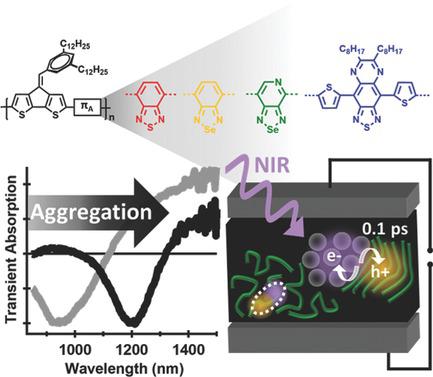当前位置:
X-MOL 学术
›
Adv. Opt. Mater.
›
论文详情
Our official English website, www.x-mol.net, welcomes your feedback! (Note: you will need to create a separate account there.)
Preferential Charge Generation at Aggregate Sites in Narrow Band Gap Infrared Photoresponsive Polymer Semiconductors
Advanced Optical Materials ( IF 9 ) Pub Date : 2018-02-13 , DOI: 10.1002/adom.201701138 Dana B. Sulas 1 , Alexander E. London 2 , Lifeng Huang 2 , Lihua Xu 3 , Zhenghui Wu 4 , Tse Nga Ng 4 , Bryan M. Wong 3 , Cody W. Schlenker 1 , Jason D. Azoulay 2 , Matthew Y. Sfeir 5
Advanced Optical Materials ( IF 9 ) Pub Date : 2018-02-13 , DOI: 10.1002/adom.201701138 Dana B. Sulas 1 , Alexander E. London 2 , Lifeng Huang 2 , Lihua Xu 3 , Zhenghui Wu 4 , Tse Nga Ng 4 , Bryan M. Wong 3 , Cody W. Schlenker 1 , Jason D. Azoulay 2 , Matthew Y. Sfeir 5
Affiliation

|
Infrared organic photodetector materials are investigated using transient absorption spectroscopy, demonstrating that ultrafast charge generation assisted by polymer aggregation is essential to compensate for the energy gap law, which dictates that excited state lifetimes decrease as the band gap narrows. Short sub‐picosecond singlet exciton lifetimes are measured in a structurally related series of infrared‐absorbing copolymers that consist of alternating cyclopentadithiophene electron‐rich “push” units and strong electron‐deficient “pull” units, including benzothiadiazole, benzoselenadiazole, pyridalselenadiazole, or thiadiazoloquinoxaline. While the ultrafast lifetimes of excitons localized on individual polymer chains suggest that charge carrier generation will be inefficient, high detectivity for polymer:PC71BM infrared photodetectors is measured in the 0.6 < λ < 1.5 µm range. The photophysical processes leading to charge generation are investigated by performing a global analysis on transient absorption data of blended polymer:PC71BM films. In these blends, charge carriers form primarily at polymer aggregate sites on the ultrafast time scale (within our instrument response), leaving quickly decaying single‐chain excitons unquenched. The results have important implications for the further development of organic infrared optoelectronic devices, where targeting processes such as excited state delocalization over aggregates may be necessary to mitigate losses to ultrafast exciton decay as materials with even lower band gaps are developed.
中文翻译:

在窄带隙红外光响应聚合物半导体中的聚集位点处产生优先电荷
使用瞬态吸收光谱法研究了红外有机光电探测器材料,证明了由聚合物聚集辅助的超快电荷产生对于补偿能隙定律是必不可少的,该定律规定了随着带隙变窄,激发态寿命会缩短。在与结构相关的一系列红外吸收共聚物中,测量了亚皮秒的单态激子的短寿命,该共聚物由交替的环戊二噻吩富电子“推”单元和强电子缺乏“拉”单元(包括苯并噻二唑,苯并硒二唑,吡啶并硒二氮杂或噻二唑并喹喔啉)组成。虽然激子的寿命超短,它位于单个聚合物链上,这表明电荷载流子的生成效率低下,但对聚合物的检测能力很高:PC 71BM红外光电探测器的测量范围为0.6 <λ<1.5 µm。通过对共混聚合物:PC 71 BM膜的瞬态吸收数据进行全局分析,研究了导致电荷产生的光物理过程。在这些混合物中,电荷载体主要形成在超快时间尺度上的聚合物聚集位点(在我们的仪器响应范围内),而使快速衰减的单链激子不被猝灭。该结果对有机红外光电器件的进一步发展具有重要意义,因为随着具有甚至更低带隙的材料的开发,可能需要针对诸如聚集体上的激发态离域的靶向过程,以减轻超快激子衰减的损失。
更新日期:2018-02-13
中文翻译:

在窄带隙红外光响应聚合物半导体中的聚集位点处产生优先电荷
使用瞬态吸收光谱法研究了红外有机光电探测器材料,证明了由聚合物聚集辅助的超快电荷产生对于补偿能隙定律是必不可少的,该定律规定了随着带隙变窄,激发态寿命会缩短。在与结构相关的一系列红外吸收共聚物中,测量了亚皮秒的单态激子的短寿命,该共聚物由交替的环戊二噻吩富电子“推”单元和强电子缺乏“拉”单元(包括苯并噻二唑,苯并硒二唑,吡啶并硒二氮杂或噻二唑并喹喔啉)组成。虽然激子的寿命超短,它位于单个聚合物链上,这表明电荷载流子的生成效率低下,但对聚合物的检测能力很高:PC 71BM红外光电探测器的测量范围为0.6 <λ<1.5 µm。通过对共混聚合物:PC 71 BM膜的瞬态吸收数据进行全局分析,研究了导致电荷产生的光物理过程。在这些混合物中,电荷载体主要形成在超快时间尺度上的聚合物聚集位点(在我们的仪器响应范围内),而使快速衰减的单链激子不被猝灭。该结果对有机红外光电器件的进一步发展具有重要意义,因为随着具有甚至更低带隙的材料的开发,可能需要针对诸如聚集体上的激发态离域的靶向过程,以减轻超快激子衰减的损失。


























 京公网安备 11010802027423号
京公网安备 11010802027423号